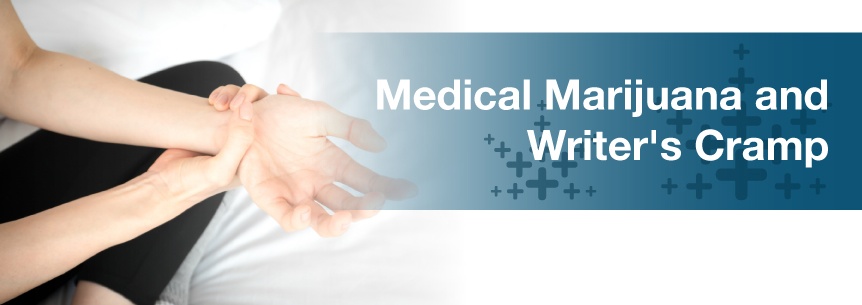
Writer’s cramp can be a deeply concerning and debilitating disease to live with. The symptoms of this condition can burden an individual with both physical and mental afflictions, interfering in their social, professional and personal lives. Thankfully, treatment options like medical marijuana can help alleviate the symptoms associated with writer’s cramp and improve an individual’s quality of life. If you suffer from physical or emotional discomfort as a result of writer’s cramp symptoms, you may consider using cannabis as a treatment option for this condition.
Writer’s cramp is clinically known as a type of dystonia. Dystonia is classified as a movement disorder that affects the muscles. This disorder produces either intermittent or persistent muscle contractions. These contractions are abnormal and typically repetitive, often resembling a tremor. Though dystonia can happen without reason, contractions can be caused or aggravated by voluntary movements. It’s not uncommon for patients with dystonia in one set of muscles to occasionally feel their symptoms in surrounding muscle groups during contractions.
Dystonia is both a disorder and a symptom, existing alone as multiple forms and as a symptom of other diseases. Writer’s cramp is a focal dystonia of the forearm, fingers, and hands that may be diagnosed as focal hand dystonia, arm dystonia, finger dystonia or general DYT1 dystonia. It can be a primary or secondary disorder, but many who experience writer’s cramp will likely also suffer from symptoms of another dystonic disorder.
Though examples of dystonia can be found throughout historical literature dating back to Dante Alighieri’s description in 1315, the contemporary medical community agrees that generalized dystonia was first formally recognized as an official disorder in 1911. Writer’s cramp has been documented for centuries, specifically as a condition often classified as a craft neurosis because symptoms were present in those who performed specific muscular movements frequently in their occupation. Once thought to be a spinal cord disorder, it’s since been classified as a focal dystonia originating from the brain.
All forms of dystonia, including writer’s cramp, can be diagnosed without discrimination to sex, age or ethnic background. Current statistics and findings report that:
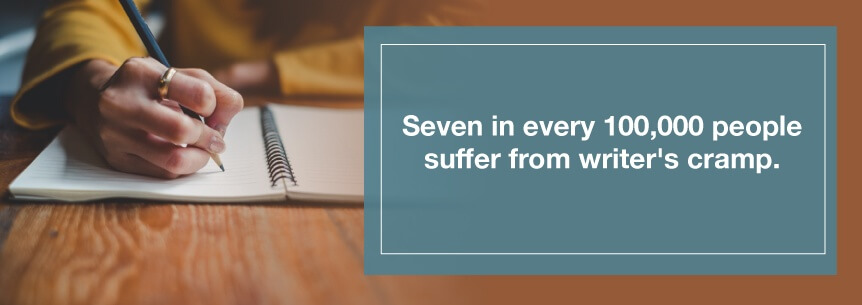
Despite its misleading name, writer’s cramp is not a condition that is exclusive to those who write constantly. In fact, all genders, ages, and ethnic backgrounds are at risk for dystonia. Similar dystonia cramping can impact musicians, athletes, typists or those with no apparent cause or family history of writer’s cramp. Those who have been reported to inherit writer’s cramp from a family member are usually not isolated — they frequently show signs of early-onset generalized dystonia.
Writer’s cramp can be classified as one of two basic types: simple and dystonic. Those with simple writer’s cramp experience difficulty and discomfort while performing a specific and singular task such as writing or typing. This motion and movement cause the dystonic symptoms to increase. Dystonic writer’s cramp occurs when difficulty and discomfort are present when the individual is performing any tasks with the afflicted muscles. Whereas simple writer’s cramp may only occur when writing, dystonic writer’s cramp could occur while writing, shaving, using cutlery, etc.
Depending on the diagnosis and whether other dystonic disorders are also present, an individual suffering from writer’s cramp can experience a variety of symptoms that range from mild discomfort to a severe inability to complete daily tasks. Physical symptoms can include the following:
Though the primary symptom is the inability to use the hand for an intended purpose, any case of writer’s cramp could potentially include symptoms of muscle jerks, spasms, stiffness, tension, fatigue and pain. It’s also important to note that those suffering from writer’s cramp may also suffer from psychological issues. According to research, many writer’s cramp patients exhibited state and trait anxiety disorders more frequently than healthy patients. Other studies have found obsessive-compulsive behavior symptoms being exhibited by those with writer’s cramp.
It is not yet clear whether these psychological disorders existed prior to the writer’s cramp symptoms, were directly caused by the biological factors influencing the writer’s cramp or if the psychological stress and subsequent symptoms only manifested as a response to the writer’s cramp symptoms. However, it is reasonable to suggest that as an individual begins to lose the ability to successfully complete daily tasks like writing, shaving or eating with utensils, they may experience negative stressors that may manifest in any number of psychological afflictions.
Unfortunately, there is no cure for writer’s cramp according to current medical findings. However, there are a variety of treatment options available to help manage and lessen the symptoms of this disorder. Each case of dystonia is unique to the individual and requires an appropriate diagnosis and treatment plan to be determined by a licensed physician. Treatment plans may include one or more therapies, prescription medications and in some cases, surgical alternatives:
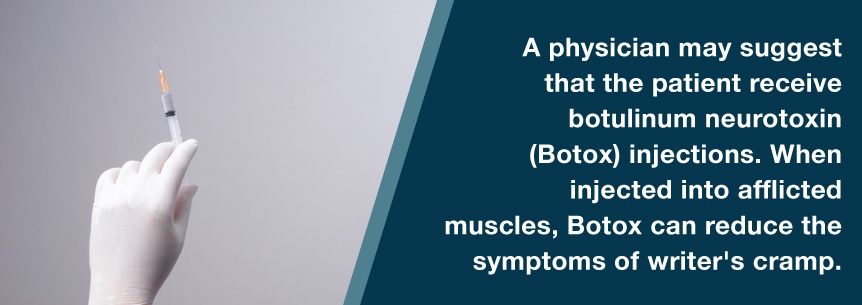
Many patients suffering from writer’s cramp find that their symptoms begin to increase, cause other forms of dystonia and further hinder daily functioning. Because there is no cure, these health plans seek to improve the patient’s quality of life as much as possible through treatment options that cause as few side effects as possible. Not all treatments will be effective for all cases. All prescription medications and surgical procedures carry inherent risks of mild to severe side effects depending on the treatment method and the individual patient.
According to new research, there is a belief that writer’s cramp may be caused by abnormalities within the brain. In one study, the brain scans of patients who have had writer’s cramp for an average of seven years were compared to brain scans of those without this ailment. Findings discovered that those suffering from writer’s cramp had less grey matter in the cerebellum, the sensorimotor cortex and the thalamus areas of the brain. All three of these areas control the hands.
Unfortunately, though the findings did show a relationship between the lack of grey matter and the presence of writer’s cramp, it was not able to offer a conclusive explanation regarding which of these abnormalities came first. There is a possibility that the lack of grey matter contributes to writer’s cramp, but there is an equal possibility that the presence of writer’s cramp affected the grey matter in these three distinct areas of the brain. Further research and study into both human and animal brain abnormalities are necessary.
Evidence for the efficacy of medical marijuana in treating writer’s cramp is primarily anecdotal, and clinical research is sorely lacking. However, there has been some research into other neurological disorders that can be effectively treated with medical marijuana, including multiple sclerosis, tinnitus and other dystonia disorders. Medical marijuana has been shown to reduce muscle spasticity in patients with multiple sclerosis. Those suffering from tinnitus report feeling mitigated symptoms after medical marijuana use. Patients suffering from other neurological disorders have also stated that medical marijuana has lessened their discomfort.
One open trial on five patients with dystonia disorders like writer’s cramp produced results that suggested medical marijuana lessened the severity of their symptoms. Another study was conducted on hamsters using a synthetic cannabinoid which successfully improved their quality of life. The positive results from these trials suggest that there is a potential for medical marijuana to treat writer’s cramp. In fact, some trials have shown that cannabis has the ability to treat dystonia in patients with Wilson’s disease, a condition that can cause dystonia.
According to a study published in 2004 by the Movement Disorder Society, medical marijuana was used to treat a woman who suffered from generalized dystonia as a side effect of Wilson’s disease. After inhaling medical marijuana, the patient’s symptoms greatly improved. Although this study targeted general dystonia, there is a belief that medical marijuana could have the same positive effect on writer’s cramp since the same area of the brain impacts both conditions.
Another study published by the Movement Disorder Society involved treating a patient with musician’s cramp with medicinal cannabis. The results of the study showed that tetrahydrocannabinol, also known as THC, was successful in treating the patient’s symptoms. Musician’s cramp and writer’s cramp have very similar symptoms, and there is a belief that these two conditions may, in fact, be identical. Because THC has been successfully used to treat musician’s cramp, there is a reasonable expectation that some patients with writer’s cramp may yield the same results.
Medical cannabis for writer’s cramp can be an effective treatment option for some patients. For those suffering from writer’s cramp, medical marijuana could help alleviate the symptoms of muscle spasms, muscle cramps and muscular pain. Cannabis for other forms of dystonia that also may occur with writer’s cramp is available as well.
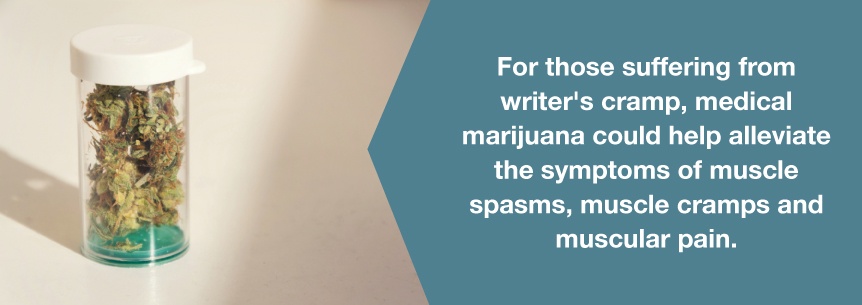
There is also the possibility that those suffering from writer’s cramp may also be dealing with other psychological conditions that are caused by, correlated with or influenced by the onset and progression of this dystonic disorder. For instance, writers or those in similar professions may find their occupations difficult or potentially impossible due to their writer’s cramp. This could cause them to feel anxious, depressed or stressed with the situation. Various medical cannabis strains can also help to alleviate the psychological symptoms patients with writer’s cramp may experience.
There are a variety of medical marijuana strains that may be able to help ease the symptoms of writer’s cramp — from muscle spasms to anxiety.
For muscle spasms related to writer’s cramp, these strains may help:
These strains of medical weed might be able to alleviate the muscle cramps related to writer’s cramp:
If you’re experiencing pain related to dystonia, you might try:
Anxiety can also result from writer’s cramp, and the following strains might be able to help you relax:
Similarly, depression can be a result of writer’s cramp. To help boost your mood, you might want to try:
Having writer’s cramp can be generally stressful, and these strains might be able to help alleviate some of the effects of that stress:
Like any natural or prescription medication, the use of medical marijuana could result in adverse side effects. Thankfully, these side effects are often minimal, limited or greatly reduced depending on which particular strain of cannabis you choose to ingest. Common side effects may include dry eyes and mouth, dizziness and headaches. Before trying marijuana for writer’s cramp, you should consult your physician to ensure you select the best strain and dosage for your needs.
One of the benefits of using medicinal cannabis to treat problematic health issues is that cannabis can be administered through a variety of methods. Though smoking marijuana is a common delivery option, many patients choose to avoid this treatment method because of the potential respiratory side effects that may occur. Others suffer from health conditions that prevent them from choosing to smoke as an option, but there are many additional ways to consume cannabis.
Those suffering from writer’s cramp may choose to use either of these methods of marijuana consumption to treat their discomfort. Depending on your individual symptoms, a doctor may suggest that you try one or more of these delivery methods.
Although some states have yet to legalize marijuana for medical or recreational use, there are many others that have made marijuana accessible to their residents. Each state governs marijuana usage according to their own unique laws, so the legal use of marijuana recreationally or medically will vary from state to state. For more information regarding medical marijuana states, card programs and laws, view our helpful guide.
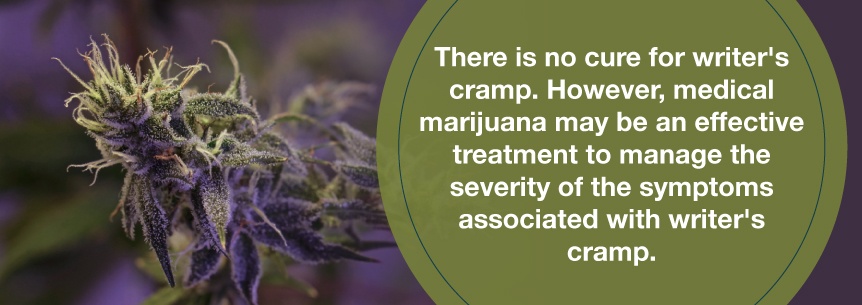
There is no cure for writer’s cramp. However, medical marijuana may be an effective treatment to manage the severity of the symptoms associated with writer’s cramp. MarijuanaDoctors.com can connect you with a cannabis doctor in your area that can help you determine what strains of medical marijuana would be an effective cannabis treatment option for your writer’s cramp symptoms. We can also help you identify nearby dispensaries where you can browse each unique cannabis strain.
Find A Doctor Find A Dispensary